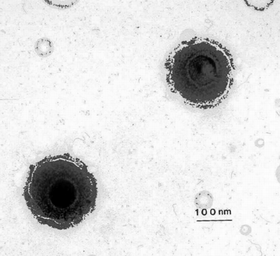December 5, 2005 feature
Detecting Single Viruses, Nanoparticles in Real-Time

Two researchers at the Institute of Optics, University of Rochester, New York, have developed a method to detect and recognize single viruses and other nanoparticles in one millisecond. Co-authors Filipp V. Ignatovich, a graduate student studying towards his PhD, and Professor Lukas Novotny published their findings on a new nanoparticle sensor in Physical Review Letters.
One key aspect of the sensor was using interferometric detection. "The interferometrical process combines two laser beams that are related to each other to make an interferometric pattern," Ignatovich said.
A beamsplitter divided a 532nm laser beam into a reference beam and a beam that scientists focus into a nanoscale channel. They put a particle solution through this channel with electroosmosis.
"Electroosmosis is liquid movement using electrodes. We dip a positive electrode on one side of a glass tube and a negative electrode on the other and apply voltage," Ignatovich explained. The amount of voltage determined how fast a particle moves inside the tube.
Only one particle at a time crossed the laser focus because of the channel's dimensions and the focus size. The laser caused the particle to brighten. "The extent of brightness of the nanoparticle depends on the particle's properties, such as size and amount of transparency," Ignatovich said.
Ignatovich and Novotny recombined the scattered light from the particle with the reference beam, which they had weakened. They put the combined beam on the center of a split photodetector. "Like a photodetector, a split photodetector converts light into voltage. But the split detector has two separate parts, giving two voltage outputs," Ignatovich said.
Since the combined beam was in the center of the detector, both sides had an equal amount of voltage. The left side's value minus the right side's value gave a differential signal of zero and therefore, a signal free of background. "The signal changed from zero only with intereference from a scattered beam that resulted in an interferometric pattern," added Ignatovich.
A pinhole of 500 microns reduced the amount of ambient light, or outside light that might affect measurements, on the split detector. The split detector ensured the best "signal to noise ratio (SNR)." "Any experiment's measurements contains noise. If SNR is less than one, we can't detect a particle," Ignatovich said. In other words, a higher SNR means less noise and better detection.
The scientists weakened the reference beam to 1.6uW to get the best SNR and therefore, to get the best signal. They discovered that SNR is proportional to the third power of particle size. "SNR for a 10nm particle is eight times (2x2x2) higher than a 5nm particle," Ignatovich gave as an example.
On the other hand, previous methods that used scattering light had a SNR proportional to the sixth power of scattering light power, causing the particle to disappear quickly. The SNR in the new method also relied on the laser beam pointing instability, instead of laser power noise, which was difficult to control.
Scientists determined scattered light amplitude, which was dependent on a particle's properties. "Differential signal amplitude is the essence of our detection scheme," Ignatovich stressed. The scientists discovered that the amplitude increased with particle radius.
The scientists used polystyrene beads, spherical particles made of a type of plastic; gold nanoparticles; and the Influenza AX-31 virus. They performed a set of three experiments: a blend of 15nm and 50nm polystyrene beads in water, 7nm and 20nm gold particles in water, and Influenza virus with 100nm polystyrene beads in water.
Results showed the method detected gold particles as small as 5nm and polysterene beads of size 10nm. The scientists also distinguished the Influenza virus from other particles of similar size. "Since viruses resemble the optical properties of polystyrene beads more closely than metal particles, we can detect viruses down to 10nm," Ignatovich said.
This method is an improvement over previous detection methods, where the particle had to be motionless, the signal had a background, or detection wasn't in real-time.
"Our method detected biowarfare viruses. However, we expect that our sensor can find other uses, such as particle tracking inside a cell or control of particulate matter in the semiconductor industry," Ignatovich reasons.
For now, the scientists are continuing to study their detection method. "We want to prove our method works. In the future, we plan to apply this technique to detect particles and viruses in the air," Ignatovich says.
Image copyright: wadsworth.org/
by Syeda Hamdani, Copyright 2005 PhysOrg.com

















